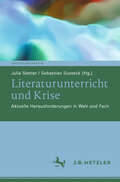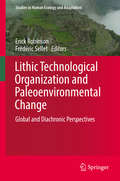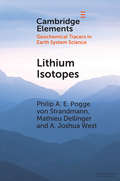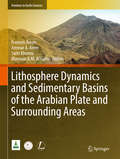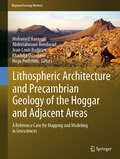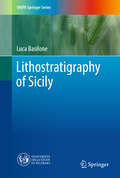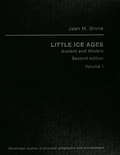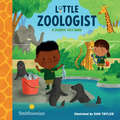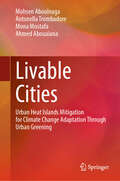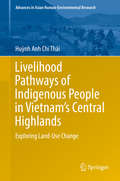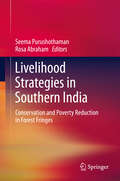- Table View
- List View
Literaturunterricht und Krise: Aktuelle Herausforderungen in Welt und Fach (Deutschdidaktik)
by Julia Stetter Sebastian SusteckDer Literaturunterricht steht unter Druck. Bildungspolitisch ungeliebt und didaktisch zunehmend ratlos betrachtet, lässt Literatur sich nur schwer in Kompetenzraster integrieren und steht zudem im Verdacht, zu den existenziellen Problemen der Gegenwart zu wenig zu sagen zu haben. Der Band öffnet neue Perspektiven auf den heutigen Literaturunterricht, der in multiplen Krisen gefangen scheint und im Kreuzfeuer von Entwicklungen steht, die allgemein mit Problemen deutscher Schulen assoziiert werden. Die Beiträge betonen dagegen die Bedeutung der Literatur für den Unterricht sowie die Rolle des Literaturunterrichts in der Reaktion auf die Krisen der Gegenwart.
Lithic Technological Organization and Paleoenvironmental Change
by Erick Robinson Frédéric SelletThe objective of this edited volume is to bring together a diverse set of analyses to document how small-scale societies responded to paleoenvironmental change based on the evidence of their lithic technologies. The contributions bring together an international forum for interpreting changes in technological organization - embracing a wide range of time periods, geographic regions and methodological approaches. As technology brings more refined information on ancient climates, the research on spatial and temporal variability of paleoenvironmental changes. In turn, this has also broadened considerations of the many ways that prehistoric hunter-gatherers may have responded to fluctuations in resource bases. From an archaeological perspective, stone tools and their associated debitage provide clues to understanding these past choices and decisions, and help to further the investigation into how variable human responses may have been. Despite significant advances in the theory and methodology of lithic technological analysis, there have been few attempts to link these developments to paleoenvironmental research on a global scale.
Lithic Technological Systems and Evolutionary Theory
by Nathan Goodale William Andrefsky Jr.Stone tool analysis relies on a strong background in analytical and methodological techniques. However, lithic technological analysis has not been well integrated with a theoretically-informed approach to understanding how humans procured, made, and used stone tools. Evolutionary theory has great potential to fill this gap. This collection of essays brings together several different evolutionary perspectives to demonstrate how lithic technological systems are a byproduct of human behavior. The essays cover a range of topics, including human behavioral ecology, cultural transmission, phylogenetic analysis, risk management, macroevolution, dual inheritance theory, cladistics, central place foraging, costly signaling, selection, drift, and various applications of evolutionary ecology.
Lithium Isotopes: A Tracer of Past and Present Silicate Weathering (Elements in Geochemical Tracers in Earth System Science)
by Philip A. Strandmann Mathieu Dellinger A. Joshua WestLithium isotopes are a relatively novel tracer of present and past silicate weathering processes. Given that silicate weathering is the primary long-term method by which CO2 is removed from the atmosphere, Li isotope research is going through an exciting phase. We show the weathering processes that fractionate dissolved and sedimentary Li isotope ratios, focusing on weathering intensity and clay formation. We then discuss the carbonate and silicate archive potential of past seawater δ7Li. These archives have been used to examine Li isotope changes across both short and long timescales. The former can demonstrate the rates at which the climate is stabilised from perturbations via weathering, a fundamental piece of the puzzle of the long-term carbon cycle.
Lithofacies Paleogeography and Geological Survey of Shale Gas (The China Geological Survey Series)
by Wei Liang Chuanlong Mou Xiuping Wang Qiyu Wang Xiangying Ge Bowen Zan Kenken Zhou Xiaowei ChenThis is an open access book. This book presents new theory and methods on compiling lithofacies paleogeographic maps as a key tool for guiding geological survey on shale gas. The fundamental goal of the shale gas geological survey is to find the ‘dessert’ area. It is therefore suggested that the lithofacies paleogeographic study and the technique of mapping should be a solid scientific basis for shale gas exploration. It takes Ordovician Wufeng-Silurian Longmaxi Formation in Sichuan Basin and its adjacent area as an example to illustrate how to find the ‘dessert’ area of shale gas in geological survey phase by compiling lithofacies paleogeographic map. It’s a valuable reference for both scientific research and teaching courses in the fields of sedimentary lithofacies, paleogeography, stratigraphy, and oil and gas.
Lithosphere Dynamics and Sedimentary Basins of the Arabian Plate and Surrounding Areas
by François Roure Ammar A. Amin Sami Khomsi Mansour A. M. Al GarniPresenting selected papers from the International Lithosphere Program (ILP) Task Force, this book highlights the links between deep Earth (mantle) and shallow processes in areas of active tectonics in the Arabian Plate and surrounding areas. It also provides key information on energy resources in these areas. It comprises a collection of research studies from the Middle East, North Africa and the Mediterranean domain, focusing on (1) the lithospheric architecture of the Arabian Plate, (2) tectonics and sedimentation in the Gulf of Corinth, (3) Triassic carbonate breccias and seismic imagery in Iraq, (4) reservoirs, aquifers and fluid transfers in Saudi Basins, (5) salt tectonics in Yemen, and (6) Cretaceous-Eocene foreland inversions in Saudi Arabia.
Lithosphere Dynamics and Sedimentary Basins: The Arabian Plate and Analogues
by Francois Roure Khalid Al Hosani Richard Ellison Stephen LokierThis book will constitute the proceedings of the ILP Workshop held in Abu Dhabi in December 2009. It will include a reprint of the 11 papers published in the December 2010 issue of the AJGS, together with 11 other original papers.
Lithosphere Dynamics and Sedimentary Basins: The Arabian Plate and Analogues (Frontiers in Earth Sciences)
by Francois Roure Khalid Al Hosani Richard Ellison Stephen LokierThis book will constitute the proceedings of the ILP Workshop held in Abu Dhabi in December 2009. It will include a reprint of the 11 papers published in the December 2010 issue of the AJGS, together with 11 other original papers.
Lithospheric Architecture and Precambrian Geology of the Hoggar and Adjacent Areas: A Reference Case for Mapping and Modeling in Geosciences (Regional Geology Reviews)
by Abderrahmane Bendaoud Mohamed Hamoudi Jean-Louis Bodinier Khadidja Ouzegane Hugo PerfettiniThis book presents the latest advances in mapping the geological structures and modeling the geodynamical and petrological processes in the Hoggar shield and adjacent areas of the northeast West African Craton, which is home to the oldest rocks in Algeria. Its respective chapters discuss the structural geology, geophysical methods, igneous processes, metamorphic petrology and metallogeny. The mapping and modeling are based on satellite data and scanning electron microscopy (SEM), so the mapping ranges from continental to crystalline scale and the ages range from 3.2 Ga to the recent Cenozoic. Further, various types of commercial and open source software (partially developed by the authors) were used. Gathering papers by respected experts in the methods applied and the Algerian Precambrian domain, the book offers a valuable reference guide to a range of mapping and modeling methodologies, as well as a geological and geophysical description of the Hoggar shield and the northeast West African Craton.
Lithostratigraphy of Iran (Springer Geology)
by Mansour GhorbaniThis book discusses the entire lithostratigraphy of Iran from the Proterozoic to recent. This unique book manages to elucidate the stratigraphy of Iran, after an exhausting and long-term process; the creation of a comprehensive stratigraphic framework required input from many Iranian specialist stratigraphers - a process which will be ongoing in the future. However, the main purpose of this work is to provide a concise summary of the state of the art of the lithostratigraphy for Iranian formations. The geology of the various sedimentary basins is described for each geological time period, together with the constituent lithostratigraphic units. The available stratigraphic data are summarized in tables, providing all relevant references. Finally, the book presents the spatial and temporal distribution of the various formations, together with their geographic locations, type sections and lithological composition.
Lithostratigraphy of Sicily
by Luca BasiloneThis book offers as comprehensive an overview as possible of the lithostratigraphy of the Italian region of Sicily, taking into account the multiplicity of formational and terminological variability developed over more than a century of studies and publications. It presents stratigraphic terminology, the geological lexicon and the main stratigraphic subdivisions that are not familiar to Sicilian geologists. The new stratigraphic methods and the use of formations as mapping units have prompted the acquisition of new lithostratigraphic data, and a review of the previous units and their comparison with the new collected data, enabling the definition of a number of new lithostratigraphic units. The book summarizes the results in 77 worksheets containing the most important information regarding the lithological, sedimentological and microfacies characteristics, the measured thicknesses, areal extent and the regional aspects, the paleoenvironmental, paleogeographic and paleo-tectonics setting, compiled according to standard procedures and nomenclature rules provided by the International Commission on Stratigraphy (ICS).
Little Gardener's First 100 Words
by Tenisha BernalThe perfect primer for budding gardeners, this board book introduces little ones to 100 different items found in the garden!From bugs to tools, each page in this unique first words book is filled with things found in the garden—above and below the ground!Little ones can learn about the parts of a plant, the different herbs, fruits, and vegetables that can grow in a garden, and the names of tools that make gardening easier. There is even a page dedicated to urban gardening for those who don't have yards!Detailed illustrations and brightly colored backgrounds are sure to engage even the youngest of nature enthusiasts. This perfect gift for budding gardeners will show them the tools they need to create and care for their very own garden.
Little Ice Ages Vol1 Ed2: Ancient And Modern (Routledge Studies In Physical Geography Ser. #Vol. 5)
by Jean M GroveFirst published in 2004. Since The Little Ice Age was published in 1988, interest in climatic history has grown rapidly and research in the area has flourished. A vast amount of new data has become available from sources such as ice cores, speleothems and tree rings. The picture that we have of past climates and glacier oscillations has extended further into the past and has become more detailed. However, the knowledge of climate change on the decennial and centennial timescale, to which glacier history can contribute, is scarce and is in demand when attempting to predict future change, especially with regard to global warming. New chapters and material have been included throughout the book, which tend to confirm and elaborate on the conclusions of the first edition. The glacial evidence has been presented in the context of the oceanographic and icecap studies that have provided such exciting results. Little Ice Ages is structured in three parts: • Part 1 details the evidence for glacier variations in the last thousand years in different parts of the world and the associated climatic fluctuations. • Part 2 brings together the evidence for the timing of glacier variations in the course of the Holocene. • Part 3 views the Holocene record in a longer time context, especially as it appears in ice cores, and goes on to consider the likely causes of climatic variability on a Little Ice Age timescale and some of its physical, biological and human consequences. It becomes apparent in Little Ice Ages that the glacier record provides a valuable indication of the nature of climatic fluctuations on the land areas of the globe. The record points to periods of cooling which were more numerous and less continuous than was believed to be the case twenty years ago. There appears to be no single explanation for the variability. Volcanism, solar variability and ocean currents have all played their parts and prediction continues to present many problems. Some authorities have thrown doubt on the existence of the Little Ice Age, but Little Ice Ages makes the case for a climatic sequence that can usefully be called the Little Ice Age and which had predecessors occurring at intervals of several centuries throughout much of the last 10,000 years.
Little Ice Ages Vol2 Ed2: Ancient And Modern (Routledge Studies In Physical Geography Ser. #Vol. 5)
by Jean M GroveFirst Published in 2004. Routledge is an imprint of Taylor & Francis, an informa company.
Little Loon
by Fran HodgkinsLittle Loon traces the birth and first summer of a loon chick on a New England lake, ending with the loon&’s migration for the winter. Readers follow along as the baby loon grows and discovers the world around her. Along the way, they&’ll learn that loons are so perfectly adapted to life in the water that it&’s very difficult for them to walk on land. They only come out of the water to lay eggs, so their nests are built are very close to shore and are very susceptible to flooding in heavy rains. Readers will also discover that the biggest threats to loons come from people—boats, pollution, and fishing tackle. Lavishly illustrated in full color, the book closes with a page of pertinent loon facts and ways for children to help protect this beloved waterfowl.
Little Zoologist (A Science Tots Book)
by Dan TaylorTeach your baby all about being a zoologist with this new board book published in partnership with Smithsonian.Scales. Notebooks. Habitats. Microscopes. Zoologists do a lot more than just feed and take care of animals and now young babies and toddlers will be able to learn all about what it means to be a zoologist and what tools they use as part of their job in this exciting and fun book in a new board book series published in conjunction with the Smithsonian Institute.
Livable Cities: Urban Heat Islands Mitigation for Climate Change Adaptation Through Urban Greening
by Antonella Trombadore Mohsen Aboulnaga Mona Mostafa Ahmed AbouaianaLivable Cities: Urban Heat Islands Mitigation for Climate Change Adaptation Through Urban Greening elucidates on livability in urban areas, providing readers with definitions and indicators of what makes a city livable. It comprehensively introduces the urban heat island effect (UHIE) and offers strategies for mitigating high surface temperatures in metropolitan areas and adapting to climate change (CC). The coverage highlights the linkage between UHIE and Sustainable Development Goals (SDGs), the socio-economic impacts of urban heat islands (UHIs), their effect on livability for citizens, and the costs and benefits of mitigating UHI. In addition, it encompasses background information about the problems and challenges that megacities face in the 21st century, followed by the cooling benefits that can be achieved from the different types of urban green coverage (UGC), whether conventional or innovative. The book presents case studies on six cities that have successfully applied UGC: Chicago (United States), Curitiba (Brazil), Stuttgart (Germany), Tokyo (Asia), Melbourne (Australia), and Johannesburg (South Africa). Additional case studies illustrate UHIE mapping in greater Cairo, Egypt, and Rome, Italy, to determine hot spot areas that need interventions and prioritization of UGC. Highlights also include the role of blue and green infrastructures in creating livable cities in the post-COVID-19 world, trends of bi-correlation between urban green spaces (UGSs), UGC, and COVID-19, and global patterns of UGSs to shape better healthy, sustainable, and resilient cities. Explains urban heat islands, their causes, and strategies for climate change adaptation to create livable cities; Highlights the role of urban green coverage in post-COVID-19 regulations in shaping more livable, sustainable, and resilient cities.Explores ways to reduce the urban heat island effect by exploiting urban greening to mitigate high temperatures in large cities like Cairo and Rome.
Live Sustainably Now: A Low-Carbon Vision of the Good Life
by Karl CoplanAny realistic response to climate change will require reducing carbon emissions to a sustainable level. Yet even people who already recognize that the climate is the most urgent issue facing the planet struggle to understand their individual responsibilities. Is it even possible to live with a sustainable carbon footprint in modern American society—much less to live well? What are the options for those who would like to make climate awareness part of their daily lives but don’t want to go off the grid or become a hermit?In Live Sustainably Now, Karl Coplan shares his personal journey of attempting to cut back on carbon without giving up the amenities of a suburban middle-class lifestyle. Coplan chronicles the joys and challenges of a year on a carbon budget—kayaking to work, hunting down electric-car charging stations, eating a Mediterranean-style diet, and enjoying plenty of travel on weekends and vacations while avoiding long-distance flights. He explains how to set a personal carbon cap and measure your actual footprint, with his own results detailed in monthly diary entries. Presenting the pros and cons of different energy, transportation, and lifestyle options, Live Sustainably Now shows that there does not have to be a trade-off between the ethical obligation to maintain a sustainable carbon footprint and the belief that life should be fulfilling and fun. This powerful and persuasive book provides an individual-level blueprint for a carbon-sustainable tweak to the American dream.
Lived Experiences of Resilience in Disaster: Riding the Waves of Survival and Making Meaning
by Theresia CitraningtyasCapturing new waves of thought on resilience and recovery, Citraningtyas explores how people survive and make meaning in disasters by bringing together survivor experiences from natural disaster events in two vastly different cultural contexts. By presenting a holistic model of conceptualising people’s experiences of dealing with disastrous situations, this book transcends psychiatric approaches of trauma recovery. It uses metaphors to present harrowing and inspiring survivor narratives from the 2004 tsunami in Aceh and the 2003 Canberra bushfires and analyzes the ways in which survivors tried to cope and make sense of their experiences as well as their own lives, in order to cope. Through embodied metaphors to unravel different aspects of meaning‑making following disasters, Citraningtyas provides insights into how culture can shape our experiences and responses to disaster, and brings forth deep commonalities in inherently human experiences.This book will appeal to researchers interested in understanding trauma resilience and recovery as well as mental health practitioners and disaster survivors.
Livelihood Enhancement Through Agriculture, Tourism and Health (Advances in Geographical and Environmental Sciences)
by R. B. Singh Narayan Chandra Jana Anju SinghAgriculture is the backbone of our economic system. It provides not only food and raw material but also employment opportunities to a very large number of people. Higher atmospheric temperature has an impact on crop yields while the changes in rainfall could affect both crop quality and quantity. Climate change, therefore, could increase the prices of major crops in some regions. For the most vulnerable people, lower agricultural output means lower income. In addition, climate change is expected to increase the risk of illness and death from extreme heat and poor air quality. Recent evidence is the COVID-19 pandemic. Furthermore, climate change also affects the occurrence of other infectious diseases. A number of well-known diseases are climate-sensitive - malaria, dengue fever, and cholera among others. Tourism is considered as an industry and alternative contributor to a nation’s income. It can generate employment opportunities and boost up the economy. This book, consisting of 26 chapters, focuses on the issues of agriculture, tourism and health for livelihood enhancement. It is essential to discuss these diverse issues in the field of geography as it encompasses interdisciplinary topics. The range of concerns at the national, regional and local levels is not confined to geography only but also involves other disciplines as well. Therefore, this book is a valuable source for scientists and researchers in allied fields such as livelihood, agriculture, land use, tourism management, health care and tribal studies. Furthermore, this book can be of immense help to the researchers, planners and decision makers engaged in solving problems in these areas in developing countries and beyond.
Livelihood Pathways of Indigenous People in Vietnam’s Central Highlands: Exploring Land-Use Change (Advances in Asian Human-Environmental Research)
by Huỳnh Anh Chi TháiThis study focuses on impacts of the environmental and socio-economic transformation on the indigenous people's livelihoods in Vietnam's Central Highlands recent decades since the country's reunification in 1975.The first empirical section sheds light on multiple external conditions (policy reforms, population trends, and market forces) exposed onto local people. The role of human and social capital is examined again in a specific livelihood of community-based tourism to testify the resilience level of local people when coping with constraints. The study concludes with an outlook on implications of development processed which still places agriculture at the primary position livelihood, and pays attention to human capital and social capital of indigenous groups in these highlands.
Livelihood Strategies in Southern India
by Seema Purushothaman Rosa AbrahamThis volume is a compilation of essays that focus on livelihood issues faced by forest communities of the southern Western Ghats region of India. Communities living along the fringes of forests are, more often than not, overlooked in academic and policy discussions. However, they face considerable pressures, being sandwiched between conservation endeavours and the forces of urbanization and commercialization. The chapters in this book provide an insight into the kinds of livelihood issues these communities face and the potential means that can be adopted to sustain these livelihoods. This volume provides a unique alternative perspective by locating livelihood issues within socio-ecological-economic narratives of communities living at the intersection of the three southern Indian states of Karnataka, Kerala and Tamil Nadu, and suggests directions for policies to address these challenges.
Livelihoods and Well-Being in the Era of Climate Change: Risk to Resilience Across India
by Shahab Fazal Nasrin BanuThis volume addresses livelihood vulnerabilities due to climate change-induced socio-environmental stresses among different communities in various geographical locations in India, and discusses how the people and communities can become resilient to these stresses. Through multiple case studies and regional analyses, the authors provide a holistic understanding of the impacts of climate change on livelihoods and well-beings in India, where other works on the subject are often fragmentary and do not encompass a comprehensive presentation of these topics. This dedicated volume offers this comprehensive coverage, exploring how climate change impacts vulnerable communities, and how different actors such as vulnerable people, communities, governments, and NGOs are adopting strategies for resilience and sustainable livelihoods. As the impacts of climate change vary over geographical regions, the book targets a systematic coverage of the issue for different geographical regions in South Asia/ India, including the Himalayan region (Hilly Area), Indo-Gangetic Plain, Sundarbans (Mangroves), Coastal lands, Deccan Plateau, and Western Semi-arid and arid areas. The book is intended for social and environmental scientists, geographers, anthropologists, sociologists, regional planners, public administrators, and policymakers.
Livestock in a Changing Landscape, Volume 2: Experiences and Regional Perspectives
by Harold A. Mooney Jeroen Dijkman Pierre Gerber Shirley Tarawali Cees De HaanThe rapidly changing nature of animal production systems, especially increasing intensification and globalization, is playing out in complex ways around the world. Over the last century, livestock keeping evolved from a means of harnessing marginal resources to produce items for local consumption to a key component of global food chains. Livestock in a Changing Landscape offers a comprehensive examination of these important and far-reaching trends. The books are an outgrowth of a collaborative effort involving international nongovernmental organizations including the United Nations Food and Agriculture Organization (UN FAO), the International Livestock Research Institute (ILRI), the Swiss College of Agriculture (SHL), the French Agricultural Research Centre for International Development (CIRAD), and the Scientific Committee for Problems of the Environment (SCOPE). Volume 1 examines the forces shaping change in livestock production and management; the resulting impacts on landscapes, land use, and social systems; and potential policy and management responses. Volume 2 explores needs and draws experience from region-specific contexts and detailed case studies. The case studies describe how drivers and consequences of change play out in specific geographical areas, and how public and private responses are shaped and implemented. Together, the volumes present new, sustainable approaches to the challenges created by fundamental shifts in livestock management and production, and represent an essential resource for policy makers, industry managers, and academics involved with this issue
Living Above the Store
by Martin MelaverThe economic crash of late 2008 is just the latest evidence of the truth that many have known: that too much of our modern economy is based on a house of cards. We need businesses that not only factor their impact on people and places into their equations for success but also strive to restore the communities and environments in which they operate. Martin Melaver provides a roadmap for creating such a business. It's not only a "how to" but a "why to" that challenges business as usual to change. "Living Above the Store" brings us into the story of Melaver, Inc. , a third-generation, 70-year-old family real estate business, as it evolves toward becoming a thought and product leader in sustainable business practices. It is part business management theory and part case study, where sustainable principles meet sustainable practices, always grounded in day-to-day practice. "Living Above the Store" demonstrates how to: adopt a business model that provides for economic success while contributing to society and the environment; shape a business culture that is restorative to a workforce by helping employees realize their highest potential; leverage an ethos within a business that "ripples outward" to foster restoration of both land and community; embrace a notion of limits to growth; and reframe ideas about competition, proprietary knowledge, and business success "Living Above the Store" is for readers who care about issues of community and sustainability.
